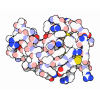[English] 日本語
 Yorodumi
Yorodumi- PDB-3vw7: Crystal structure of human protease-activated receptor 1 (PAR1) b... -
+ Open data
Open data
- Basic information
Basic information
| Entry | Database: PDB / ID: 3vw7 | ||||||
|---|---|---|---|---|---|---|---|
| Title | Crystal structure of human protease-activated receptor 1 (PAR1) bound with antagonist vorapaxar at 2.2 angstrom | ||||||
 Components Components | Proteinase-activated receptor 1, Lysozyme | ||||||
 Keywords Keywords |  Signaling protein/antagonist / High resolution structure / Signaling protein/antagonist / High resolution structure /  protease-activated receptor 1 / inactive conformation / antagonist vorapaxar / protease-activated receptor 1 / inactive conformation / antagonist vorapaxar /  G protein-coupled receptor / G protein-coupled receptor /  signaling protein / signaling protein /  membrane protein / thrombin receptor-antagonist complex / membrane protein / thrombin receptor-antagonist complex /  Signaling protein-antagonist complex Signaling protein-antagonist complex | ||||||
| Function / homology |  Function and homology information Function and homology informationnegative regulation of renin secretion into blood stream / dendritic cell homeostasis / negative regulation of glomerular filtration / thrombin-activated receptor activity / establishment of synaptic specificity at neuromuscular junction / platelet dense tubular network / cell-cell junction maintenance / regulation of interleukin-1 beta production / connective tissue replacement involved in inflammatory response wound healing / platelet dense granule organization ...negative regulation of renin secretion into blood stream / dendritic cell homeostasis / negative regulation of glomerular filtration / thrombin-activated receptor activity / establishment of synaptic specificity at neuromuscular junction / platelet dense tubular network / cell-cell junction maintenance / regulation of interleukin-1 beta production / connective tissue replacement involved in inflammatory response wound healing / platelet dense granule organization / trans-synaptic signaling by endocannabinoid, modulating synaptic transmission / regulation of sensory perception of pain / positive regulation of smooth muscle contraction / protein kinase C-activating G protein-coupled receptor signaling pathway / positive regulation of calcium ion transport / positive regulation of Rho protein signal transduction /  regulation of blood coagulation / positive regulation of cysteine-type endopeptidase activity involved in apoptotic process / G-protein alpha-subunit binding / anatomical structure morphogenesis / positive regulation of collagen biosynthetic process / positive regulation of blood coagulation / Common Pathway of Fibrin Clot Formation / homeostasis of number of cells within a tissue / release of sequestered calcium ion into cytosol / positive regulation of vasoconstriction / viral release from host cell by cytolysis / Peptide ligand-binding receptors / peptidoglycan catabolic process / positive regulation of release of sequestered calcium ion into cytosol / regulation of blood coagulation / positive regulation of cysteine-type endopeptidase activity involved in apoptotic process / G-protein alpha-subunit binding / anatomical structure morphogenesis / positive regulation of collagen biosynthetic process / positive regulation of blood coagulation / Common Pathway of Fibrin Clot Formation / homeostasis of number of cells within a tissue / release of sequestered calcium ion into cytosol / positive regulation of vasoconstriction / viral release from host cell by cytolysis / Peptide ligand-binding receptors / peptidoglycan catabolic process / positive regulation of release of sequestered calcium ion into cytosol /  caveola / G protein-coupled receptor activity / positive regulation of interleukin-8 production / positive regulation of receptor signaling pathway via JAK-STAT / caveola / G protein-coupled receptor activity / positive regulation of interleukin-8 production / positive regulation of receptor signaling pathway via JAK-STAT /  neuromuscular junction / neuromuscular junction /  platelet activation / positive regulation of GTPase activity / response to wounding / positive regulation of interleukin-6 production / G-protein beta-subunit binding / activation of cysteine-type endopeptidase activity involved in apoptotic process / cell wall macromolecule catabolic process / Thrombin signalling through proteinase activated receptors (PARs) / late endosome / platelet activation / positive regulation of GTPase activity / response to wounding / positive regulation of interleukin-6 production / G-protein beta-subunit binding / activation of cysteine-type endopeptidase activity involved in apoptotic process / cell wall macromolecule catabolic process / Thrombin signalling through proteinase activated receptors (PARs) / late endosome /  lysozyme / lysozyme /  lysozyme activity / phospholipase C-activating G protein-coupled receptor signaling pathway / positive regulation of cytosolic calcium ion concentration / lysozyme activity / phospholipase C-activating G protein-coupled receptor signaling pathway / positive regulation of cytosolic calcium ion concentration /  postsynaptic membrane / G alpha (q) signalling events / positive regulation of canonical NF-kappaB signal transduction / negative regulation of neuron apoptotic process / host cell cytoplasm / response to lipopolysaccharide / positive regulation of MAPK cascade / positive regulation of ERK1 and ERK2 cascade / positive regulation of phosphatidylinositol 3-kinase/protein kinase B signal transduction / postsynaptic membrane / G alpha (q) signalling events / positive regulation of canonical NF-kappaB signal transduction / negative regulation of neuron apoptotic process / host cell cytoplasm / response to lipopolysaccharide / positive regulation of MAPK cascade / positive regulation of ERK1 and ERK2 cascade / positive regulation of phosphatidylinositol 3-kinase/protein kinase B signal transduction /  early endosome / positive regulation of cell migration / defense response to bacterium / early endosome / positive regulation of cell migration / defense response to bacterium /  inflammatory response / G protein-coupled receptor signaling pathway / negative regulation of cell population proliferation / inflammatory response / G protein-coupled receptor signaling pathway / negative regulation of cell population proliferation /  signaling receptor binding / positive regulation of cell population proliferation / positive regulation of DNA-templated transcription / signaling receptor binding / positive regulation of cell population proliferation / positive regulation of DNA-templated transcription /  Golgi apparatus / Golgi apparatus /  cell surface / extracellular region / cell surface / extracellular region /  plasma membrane plasma membraneSimilarity search - Function | ||||||
| Biological species |   Homo sapiens (human) Homo sapiens (human)  Enterobacteria phage T4 (virus) Enterobacteria phage T4 (virus) | ||||||
| Method |  X-RAY DIFFRACTION / X-RAY DIFFRACTION /  SYNCHROTRON / SYNCHROTRON /  MOLECULAR REPLACEMENT / Resolution: 2.2 Å MOLECULAR REPLACEMENT / Resolution: 2.2 Å | ||||||
 Authors Authors | Zhang, C. / Srinivasan, Y. / Arlow, D.H. / Fung, J.J. / Palmer, D. / Zheng, Y. / Green, H.F. / Pandey, A. / Dror, R.O. / Shaw, D.E. ...Zhang, C. / Srinivasan, Y. / Arlow, D.H. / Fung, J.J. / Palmer, D. / Zheng, Y. / Green, H.F. / Pandey, A. / Dror, R.O. / Shaw, D.E. / Weis, W.I. / Coughlin, S.R. / Kobilka, B.K. | ||||||
 Citation Citation |  Journal: Nature / Year: 2012 Journal: Nature / Year: 2012Title: High-resolution crystal structure of human protease-activated receptor 1 Authors: Zhang, C. / Srinivasan, Y. / Arlow, D.H. / Fung, J.J. / Palmer, D. / Zheng, Y. / Green, H.F. / Pandey, A. / Dror, R.O. / Shaw, D.E. / Weis, W.I. / Coughlin, S.R. / Kobilka, B.K. | ||||||
| History |
|
- Structure visualization
Structure visualization
| Structure viewer | Molecule:  Molmil Molmil Jmol/JSmol Jmol/JSmol |
|---|
- Downloads & links
Downloads & links
- Download
Download
| PDBx/mmCIF format |  3vw7.cif.gz 3vw7.cif.gz | 203.9 KB | Display |  PDBx/mmCIF format PDBx/mmCIF format |
|---|---|---|---|---|
| PDB format |  pdb3vw7.ent.gz pdb3vw7.ent.gz | 159.6 KB | Display |  PDB format PDB format |
| PDBx/mmJSON format |  3vw7.json.gz 3vw7.json.gz | Tree view |  PDBx/mmJSON format PDBx/mmJSON format | |
| Others |  Other downloads Other downloads |
-Validation report
| Arichive directory |  https://data.pdbj.org/pub/pdb/validation_reports/vw/3vw7 https://data.pdbj.org/pub/pdb/validation_reports/vw/3vw7 ftp://data.pdbj.org/pub/pdb/validation_reports/vw/3vw7 ftp://data.pdbj.org/pub/pdb/validation_reports/vw/3vw7 | HTTPS FTP |
|---|
-Related structure data
| Related structure data | 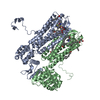 3oduS S: Starting model for refinement |
|---|---|
| Similar structure data |
- Links
Links
- Assembly
Assembly
| Deposited unit | 
| ||||||||
|---|---|---|---|---|---|---|---|---|---|
| 1 |
| ||||||||
| Unit cell |
|
- Components
Components
-Protein , 1 types, 1 molecules A
| #1: Protein | Mass: 54338.980 Da / Num. of mol.: 1 / Mutation: N250G, N259S, D1020N, C1054T, C1097A Source method: isolated from a genetically manipulated source Details: Chimera protein of residues 86-395 form Proteinase-activated receptor 1 (P25116, PAR1_HUMAN), Lyzosyme from Enterobacteria phage T4 (P00720, LYS_BPT4) and residues 303-395 from Proteinase- ...Details: Chimera protein of residues 86-395 form Proteinase-activated receptor 1 (P25116, PAR1_HUMAN), Lyzosyme from Enterobacteria phage T4 (P00720, LYS_BPT4) and residues 303-395 from Proteinase-activated receptor 1 (P25116, PAR1_HUMAN) Source: (gene. exp.)   Homo sapiens (human), (gene. exp.) Homo sapiens (human), (gene. exp.)   Enterobacteria phage T4 (virus) Enterobacteria phage T4 (virus)Production host:   Spodoptera frugiperda (fall armyworm) / References: UniProt: P25116, UniProt: P00720, Spodoptera frugiperda (fall armyworm) / References: UniProt: P25116, UniProt: P00720,  lysozyme lysozyme |
|---|
-Non-polymers , 5 types, 103 molecules 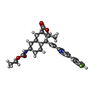
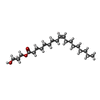







| #2: Chemical | ChemComp-VPX /  Vorapaxar Vorapaxar | ||||||
|---|---|---|---|---|---|---|---|
| #3: Chemical | ChemComp-OLC / ( #4: Chemical | ChemComp-CL / |  Chloride Chloride#5: Chemical | ChemComp-NA / | #6: Water | ChemComp-HOH / |  Water Water |
-Experimental details
-Experiment
| Experiment | Method:  X-RAY DIFFRACTION / Number of used crystals: 18 X-RAY DIFFRACTION / Number of used crystals: 18 |
|---|
- Sample preparation
Sample preparation
| Crystal | Density Matthews: 2.49 Å3/Da / Density % sol: 50.67 % |
|---|---|
Crystal grow | Temperature: 293 K Details: 0.1-0.2M sodium chloride, 100mM sodium phosphate pH 6.0-6.5, 25%-35% PEG 300, Lipidic cubic phase (in meso phase), temperature 293K PH range: 6.0-6.5 |
-Data collection
| Diffraction | Mean temperature: 93 K | ||||||||||||||||||||||||||||||||||||||||||||||||||||||||||||||||||||||||||||||||||||||||||||||||||||||||||||||||
|---|---|---|---|---|---|---|---|---|---|---|---|---|---|---|---|---|---|---|---|---|---|---|---|---|---|---|---|---|---|---|---|---|---|---|---|---|---|---|---|---|---|---|---|---|---|---|---|---|---|---|---|---|---|---|---|---|---|---|---|---|---|---|---|---|---|---|---|---|---|---|---|---|---|---|---|---|---|---|---|---|---|---|---|---|---|---|---|---|---|---|---|---|---|---|---|---|---|---|---|---|---|---|---|---|---|---|---|---|---|---|---|---|---|
| Diffraction source | Source:  SYNCHROTRON / Site: SYNCHROTRON / Site:  APS APS  / Beamline: 23-ID-B / Wavelength: 1.033 Å / Beamline: 23-ID-B / Wavelength: 1.033 Å | ||||||||||||||||||||||||||||||||||||||||||||||||||||||||||||||||||||||||||||||||||||||||||||||||||||||||||||||||
| Detector | Type: MARMOSAIC 300 mm CCD / Detector: CCD / Date: Feb 18, 2012 | ||||||||||||||||||||||||||||||||||||||||||||||||||||||||||||||||||||||||||||||||||||||||||||||||||||||||||||||||
| Radiation | Monochromator: Double crystal cryo-cooled Si(111) / Protocol: SINGLE WAVELENGTH / Monochromatic (M) / Laue (L): M / Scattering type: x-ray | ||||||||||||||||||||||||||||||||||||||||||||||||||||||||||||||||||||||||||||||||||||||||||||||||||||||||||||||||
| Radiation wavelength | Wavelength : 1.033 Å / Relative weight: 1 : 1.033 Å / Relative weight: 1 | ||||||||||||||||||||||||||||||||||||||||||||||||||||||||||||||||||||||||||||||||||||||||||||||||||||||||||||||||
| Reflection | Resolution: 2.2→30 Å / Num. all: 28455 / Num. obs: 27181 / % possible obs: 95.6 % / Observed criterion σ(F): 1 / Observed criterion σ(I): 1 / Redundancy: 4.8 % / Rmerge(I) obs: 0.135 / Χ2: 1.284 / Net I/σ(I): 7.2 | ||||||||||||||||||||||||||||||||||||||||||||||||||||||||||||||||||||||||||||||||||||||||||||||||||||||||||||||||
| Reflection shell |
|
- Processing
Processing
| Software |
| ||||||||||||||||||||||||||||||||||||||||||||||||||||||||||||||||||||||
|---|---|---|---|---|---|---|---|---|---|---|---|---|---|---|---|---|---|---|---|---|---|---|---|---|---|---|---|---|---|---|---|---|---|---|---|---|---|---|---|---|---|---|---|---|---|---|---|---|---|---|---|---|---|---|---|---|---|---|---|---|---|---|---|---|---|---|---|---|---|---|---|
| Refinement | Method to determine structure : :  MOLECULAR REPLACEMENT MOLECULAR REPLACEMENTStarting model: PDB code 3ODU Resolution: 2.2→28.273 Å / Occupancy max: 1 / Occupancy min: 0 / FOM work R set: 0.8116 / SU ML: 0.26 / σ(F): 0 / Phase error: 24.96 / Stereochemistry target values: ML
| ||||||||||||||||||||||||||||||||||||||||||||||||||||||||||||||||||||||
| Solvent computation | Shrinkage radii: 0.83 Å / VDW probe radii: 1.1 Å / Solvent model: FLAT BULK SOLVENT MODEL / Bsol: 59.432 Å2 / ksol: 0.344 e/Å3 | ||||||||||||||||||||||||||||||||||||||||||||||||||||||||||||||||||||||
| Displacement parameters | Biso max: 224.91 Å2 / Biso mean: 46.5549 Å2 / Biso min: 19.34 Å2
| ||||||||||||||||||||||||||||||||||||||||||||||||||||||||||||||||||||||
| Refinement step | Cycle: LAST / Resolution: 2.2→28.273 Å
| ||||||||||||||||||||||||||||||||||||||||||||||||||||||||||||||||||||||
| Refine LS restraints |
| ||||||||||||||||||||||||||||||||||||||||||||||||||||||||||||||||||||||
| LS refinement shell | Refine-ID: X-RAY DIFFRACTION / Total num. of bins used: 9
| ||||||||||||||||||||||||||||||||||||||||||||||||||||||||||||||||||||||
| Refinement TLS params. | Method: refined / Origin x: -4.0967 Å / Origin y: -8.5829 Å / Origin z: 27.7598 Å
| ||||||||||||||||||||||||||||||||||||||||||||||||||||||||||||||||||||||
| Refinement TLS group | Selection details: all |
 Movie
Movie Controller
Controller



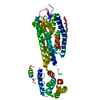
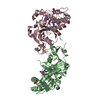
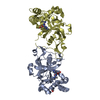
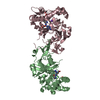
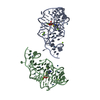


 PDBj
PDBj